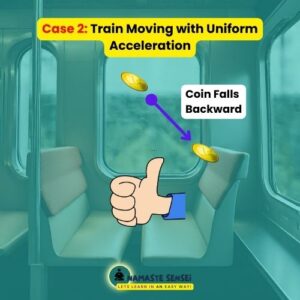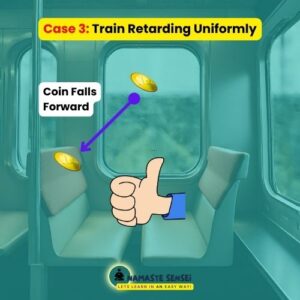Top 4 Inertia of Direction Examples In Physics & Daily Life
Here are the top 4 inertia of direction examples In Physics and real Life.
-
Car Turning on a Curve.
-
A coin thrown vertically upwards inside the train (Three Cases)
-
Plane Banking in Flight.
-
Spark Coming from a Grinding Machine.
The inertia of direction is the inability of the body to change its direction itself. This means that an object in motion will continue to move in a straight line with a constant speed and direction unless some force causes it to change its path.
Why do objects try to maintain their direction, even when it changes?
Consider a scenario: while driving a car at a constant speed along a straight road, you(the object in this case) abruptly turn the steering wheel to the left. In response, you feel a force pushing you towards the right side of the car. This phenomenon is explained by the principle of ‘inertia of direction’.
From a coin tossed in the air to a car turning a corner, ‘Inertia of Direction’ plays a pivotal role. In this article, we will explore 4 different inertia of direction examples that showcase how & why objects try to stay true to their original direction.
But before you read any further, it might be a good idea to briefly understand what inertia is and its types. We will cover them very briefly. So it is recommended to read it, as it will help you to understand the examples better. If you are already familiar with the concept, you can skip it by clicking on the link below.
What is the law of inertia in physics?
In physics, inertia is a fundamental property of matter that describes an object’s resistance to a change in its state of motion. It is one of the key principles underlying Sir Isaac Newton’s laws of motion. Inertia is often summarized by the statement:
“An object at rest tends to stay at rest, and an object in motion tends to stay in motion with the same speed and in the same direction unless acted upon by an external force.”
In simpler terms, if an object is stationary, it will remain stationary unless a force is applied to it. Similarly, if an object is moving, it will continue to move at a constant velocity in a straight line unless a force is applied to change its speed or direction.
Types of inertia with examples
Inertia can be categorized into three main types:
- Inertia of Rest: This refers to the tendency of an object to remain at rest when no external force is acting on it. In other words, an object at rest will stay at rest unless a force is applied to set it in motion.
Example: A book sitting on a table will not move on its own because it exhibits inertia of rest. It requires an external force, such as someone pushing it, to overcome this inertia and make it move. - Inertia of Motion: This describes the tendency of an object in motion to remain in motion with the same speed and in the same direction unless acted upon by an external force. It is sometimes referred to as “inertia of motion” or simply “inertia.”
Example: If you roll a ball on a smooth, frictionless surface, it will continue rolling indefinitely in a straight line unless an external force, such as friction or your hand, acts upon it to slow it down or change its direction. - Inertia of Direction: Inertia of direction is a concept related to an object’s tendency to resist changes in its direction of motion. This means that an object will continue moving in its current direction unless an external force is applied to change that direction.
Example: When you’re driving a car and suddenly make a sharp turn, you feel yourself being pushed to the side. This is because your body tends to continue moving in the direction it was initially going (inertia of motion), and the car’s rapid change in direction exerts a force on you (inertia of direction).
Now in this article, we will focus extensively on the examples of inertia of direction. So let’s dive into our top 4 inertia of direction examples in physics & daily life.
4 inertia of direction examples in physics & daily life Explained
I am sure that the concept of inertia of direction is clear to you now. If not, you can comment below. Let us now move on to 4 examples of inertia of direction in physics & in real life.
-
Car Turning on a Curve

When a car turns on a curve, the passengers inside it initially tend to continue moving in the direction they were traveling before the turn due to the inertia of direction. This means that if the car turns to the right, the passengers’ bodies have a tendency to keep moving forward, which, relative to the car’s new direction, would be to the left.
As a result, when the car turns right, passengers often lean or feel as if they are pushed to the left inside the car. This sensation occurs because their bodies resist changing their forward motion and tend to continue moving in the direction the car was traveling before the turn, in accordance with the principle of inertia of direction.
However, once the car completes the turn and continues on its new path, the passengers adjust to the new direction of motion. So, after the turn, passengers do not continue moving in the opposite direction; they align themselves with the car’s new forward motion, demonstrating the role of inertia of direction in this experience. -
A coin thrown vertically upwards inside the train (Three Cases)
Case 1: Train Moving with Uniform Velocity
In this scenario, when the train is moving with uniform velocity (constant speed and direction), the coin initially shares the train’s motion. When you throw the coin upward, it continues to move upward with the same velocity as the train, maintaining its initial direction.
This is because of the inertia of direction, as the coin resists changing its motion while inside the moving train. From an external perspective, someone outside the train would observe the coin moving vertically within the train car.
Case 2: Train Moving with Uniform Acceleration
When the train accelerates uniformly, the coin initially shares the train’s motion. When you throw the coin upward, it will continue to move upward relative to the train car due to the inertia of direction. However, inertia of direction also means that the coin resists changes in its horizontal motion.
So, from an external perspective (someone outside the train), they would observe the coin’s trajectory as not following a straight vertical path.Instead, due to the train’s acceleration, the coin will appear to fall backward toward the person who threw it. This is because, while the coin is moving upward, the train itself has moved forward since the coin was released.
The coin’s initial forward velocity inside the moving train combines with the train’s acceleration to create a curved trajectory, causing it to fall backward, illustrating the role of inertia of direction.Case 3: Train Retarding Uniformly

When the train is uniformly decelerating or slowing down, the coin initially moves with the train’s motion. When thrown upward, it will continue to move upward relative to the train car due to inertia of direction. However, inertia of direction means that the coin resists changes in its horizontal motion.From an external perspective (someone outside the train), they would observe the coin’s trajectory as not following a straight vertical path. Due to the train’s deceleration, the coin will appear to fall forward, towards the front of the train.
This is because, while the coin is moving upward, the train has slowed down since the coin was released. The coin’s initial forward velocity inside the moving train combines with the train’s deceleration to create a curved trajectory, causing it to fall forward, demonstrating the role of inertia of direction. -
Plane Banking in Flight:

When an aircraft banks or tilts during a turn, passengers inside the plane experience the effects of inertia of direction. As the plane turns, the passengers’ bodies initially want to continue moving in their original direction, which is straight ahead relative to the aircraft’s initial orientation. This tendency is due to the inertia of direction, a fundamental principle of physics.As a result, when the plane banks to the right, passengers may feel as if they are pushed to the left side of their seats. This sensation occurs because their bodies resist changing their forward motion and tend to continue moving in the direction the plane was initially traveling. You might have experienced it when traveling by airplane.
It’s important to note that the aircraft’s design, including the tilt and control systems, ensures that it maintains its intended direction despite changes in its angle of banking.
So, while passengers may feel pressed into their seats or to one side during a banked turn, the aircraft is safely following its new flight path, all while illustrating the concept of inertia of direction. -
Spark Coming from a Grinding Machine:

When you operate a grinding machine, it creates sparks as a result of the friction between the grinding wheel and the material being worked on. These sparks are tiny, incandescent particles of metal that are ejected from the grinding area.The principle of inertia of direction comes into play when these sparks are generated. Initially, these sparks tend to maintain the same direction as the motion of the grinding wheel.
This is because, in the absence of external forces acting upon them, these sparks follow the same direction as the surface they were on before becoming airborne.In other words, if the grinding wheel is moving horizontally, the sparks will also move horizontally with the same velocity due to their inertia of direction. They resist changing their direction unless influenced by external forces.
However, as these sparks move through the air, they encounter resistance from the surrounding air molecules and are affected by gravity. Over time, air resistance and gravity can cause the sparks to slow down, change direction, and eventually fall to the ground.
This demonstrates how inertia of direction initially causes the sparks to maintain their motion in the direction of the grinding wheel, but external forces eventually alter their path.
References – Inertia of Direction examples
- The Physics Classroom: Inertia
If you are interested in learning about inertia, it could be a valuable educational resource to explore. It is provided by the physics classroom.
Recommended Read:
| Inertia Of Rest Examples In Physics & Daily Life (9 Examples) |
| Inertia Of Motion Examples In Physics & Daily Life (7 Examples) |
You have finished the complete article related to 4 inertia of direction examples in physics & in daily life. If you have any doubts or queries, feel free to comment below. We will respond as soon as possible.
Or Email Us At [email protected]

